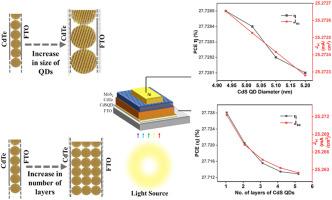Quantum size effect of CdS quantum dot as electron transport layer for enhanced performance in CdTe based solar cells
IF 4.9
3区 材料科学
Q2 CHEMISTRY, MULTIDISCIPLINARY
引用次数: 0
Abstract
In this work a comprehensive experimental and theoretical investigation was carried out to examine the influence of the quantum size effect of CdS quantum dots (QDs) when employed as an electron transport layer (ETL) in PN-type CdTe-based solar cell. Although quantum dots have been extensively employed in the field of solar energy harvesting, their application as an ETL remains relatively under-investigated. In this work, CdS QDs were synthesized via the hot injection method, followed by thorough structural and optical characterization to determine critical material parameters required for accurate device simulation using SCAPS-1D. The study systematically examines the influence of varying QD sizes and the number of QD layers on the photovoltaic performance of the device. Additionally, optimization strategies involving the tuning of the thicknesses of the hole transport layer (HTL), ETL, and absorber layer were employed to further enhance the device efficiency. Simulation results reveal that the device performance is sensitive to both the size and distribution of QDs within the ETL. A maximum power conversion efficiency of 29.68 % was achieved with a single monolayer ETL configuration and an optimized QD size of 4.7 nm, whereas 16.5 % efficiency was reported for CdS as absorber layer previously. These findings underscore the pivotal role of quantum dot engineering in modulating charge transport and recombination dynamics, thereby offering valuable insights into the design of next-generation high-efficiency solar cells.

CdS量子点作为电子传输层对CdTe基太阳能电池性能的量子尺寸效应
本文从实验和理论两方面研究了CdS量子点在pn型cdte基太阳能电池中作为电子传输层(ETL)时的量子尺寸效应。虽然量子点已广泛应用于太阳能收集领域,但其作为ETL的应用研究相对较少。在这项工作中,通过热注入法合成CdS量子点,然后进行全面的结构和光学表征,以确定使用SCAPS-1D精确模拟器件所需的关键材料参数。该研究系统地考察了不同量子点尺寸和量子点层数对器件光电性能的影响。此外,通过调整空穴传输层(HTL)、ETL和吸收层的厚度等优化策略,进一步提高了器件效率。仿真结果表明,器件性能对ETL内量子点的大小和分布都很敏感。单层ETL结构和优化的QD尺寸为4.7 nm时,最大功率转换效率为29.68%,而先前报道的CdS作为吸收层的效率为16.5%。这些发现强调了量子点工程在调制电荷输运和重组动力学中的关键作用,从而为下一代高效太阳能电池的设计提供了有价值的见解。
本文章由计算机程序翻译,如有差异,请以英文原文为准。
求助全文
约1分钟内获得全文
求助全文
来源期刊
CiteScore
7.80
自引率
2.50%
发文量
605
审稿时长
40 days
期刊介绍:
The Journal of Physics and Chemistry of Solids is a well-established international medium for publication of archival research in condensed matter and materials sciences. Areas of interest broadly include experimental and theoretical research on electronic, magnetic, spectroscopic and structural properties as well as the statistical mechanics and thermodynamics of materials. The focus is on gaining physical and chemical insight into the properties and potential applications of condensed matter systems.
Within the broad scope of the journal, beyond regular contributions, the editors have identified submissions in the following areas of physics and chemistry of solids to be of special current interest to the journal:
Low-dimensional systems
Exotic states of quantum electron matter including topological phases
Energy conversion and storage
Interfaces, nanoparticles and catalysts.

 求助内容:
求助内容: 应助结果提醒方式:
应助结果提醒方式:


